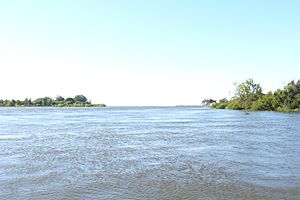San Javier River (Santa Fe) facts for kids
The San Javier River (in Spanish, Río San Javier) is a special kind of river. It's an arm or side channel of the Paraná River in the province of Santa Fe, Argentina. Think of it like a branch that splits off from a main tree trunk and then might connect back later.
Where Does the San Javier River Flow?
The lower part of the Paraná River is very wide and has many different channels, like a giant, messy braid. The San Javier River looks like it starts on its own, but it's actually connected to the main Paraná River by several smaller channels. This is where it gets most of its water!
The San Javier River begins about 15 kilometers (9 miles) south of a city called Reconquista. From there, it flows mostly south, running right next to the Paraná River. As it travels, it passes by towns like San Javier and Helvecia.
The river doesn't flow directly back into the main Paraná River at its end. Instead, it joins several other channels near Santa Rosa de Calchines. These channels connect to the Paraná and also lead into a system of lakes and waterways called Laguna Setúbal. Just like the San Javier, the Laguna Setúbal system also has connections to the main Paraná River.
The end of the San Javier River is about 40 kilometers (25 miles) northeast of Santa Fe City, which is the capital of the province. The river's journey from where it starts to where it ends is about 250 kilometers (155 miles) long. Along this path, it twists and turns a lot, creating many bends and smaller channels.
A Look Back in Time: The River's History
The San Javier River used to be known by a different name: the Quiloazas River. This river played a big role in the history of the area. The first capital city of the province was built at a place called Cayastá, which is about 85 kilometers (53 miles) upstream from where the capital is now.
However, the river caused a lot of erosion (wearing away of the land) on the riverbank where Cayastá was located. This erosion was so strong that it forced the people to abandon the original city site. Even today, the San Javier River continues to cause erosion in the area.
See also
 In Spanish: Río San Javier para niños
In Spanish: Río San Javier para niños


